What Types of Shapes Are Most Frequently Found in Artworks From the Art Nouveau Style
So off the bat what practise you think when you hear the words Art Nouveau design? Something french, classic, fancy and probably pricey? Well Art Nouveau is French for "New Art." It was intended to be art for the people and an attempt to move away from traditional art forms that were ofttimes restrictive and sectional. The Fine art Nouveau movement sought to bring beauty to all aspects of life and to all people.

In today's society, nosotros have moved more toward using different art styles from centuries ago without fifty-fifty knowing it. We implement these historic designs, like Fine art Nouveau, through our branding, graphic pattern, dwelling decor, compages and and then much more than. Looking back at the history of Art, revolutionary works of Art were non just about aesthetics but a reflection of a function of society, a motion and the desires and repulsions within a order.
Today we still utilize art in the same style, we employ it to identify ourselves with a particular movement or a schoolhouse of thought in society to draw in customers and viewers. So how do brands and design utilize Fine art Nouveau today? In this article, nosotros'll cover the history of Art Nouveau and central characteristics of Fine art Nouveau to assistance you spot it in designs today.
The history of Fine art Nouveau
—
The Art Nouveau motility began in the tardily nineteenth century and was coined by British textiles designer, author and social activist William Morris, along with other collaborators inside the Craft movement.
The Arts and Crafts motion came earlier Art Nouveau and aimed to reform quality functional blueprint by bringing nobility to Art beingness applied to day-to-24-hour interval life, which was often underrepresented and unappreciated in the fine art globe at the time. That sentiment behind the Craft motility can be seen in Art Nouveau: the want to deconstruct the traditional and frequently elitist ideas around the hierarchy inside art.

The sentiment of Fine art Nouveau is the importance of seeing the beauty in all objects: art does not have to be a lifeless painting you lot hang up merely tin be functional and available for more than just the few. This was a radical philosophy in the elitist art earth. As William Morris said "Have nothing in your house that yous do not know to be useful, or believe to be beautiful."
Keeping in touch with its British, medieval and romantic origins, Art Nouveau drew inspiration from the globe of plants and nature quite similar to the imagery associated with the artistic and literary motion romanticism. Romanticism began in the eighteenth century and had an accent on individualism, spontaneity and freedom from rules and encouraged people to rely on their imagination. However, one major element that differentiated Romanticism from Art Nouveau was that romantics criticised the industrial revolution while the Art Nouveau motion embraced it and was even fueled by it.
Fine art Nouveau and the Industrial Revolution
Art Nouveau emerged equally a reaction to major globe events including the Industrial Revolution which began in the eighteenth century. The Industrial Revolution was the transformation from a handicraft economy to i dominated by machine manufacturing through the rising of technology.
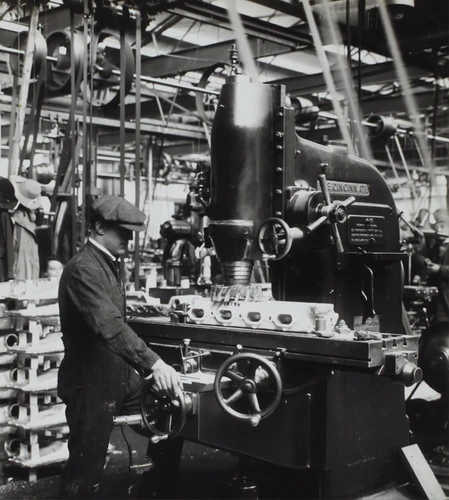
The five key factors of industrialisation are:
- Country
- Labour
- Capital letter
- Technology
- Connections
These five elements can also be seen in the Art Nouveau movement. The industrial revolution allowed for faster and cheaper product of materials making new building materials such as glass, reinforced concrete, cast fe and steel, readily bachelor. Art Nouveau artists embraced industrial production and the accessibility of materials to create their work.
Art Nouveau was able to create handmade unique pieces also as industrially produce items in guild for the not and then well off to also accept access to the finer things in life. This is what the Industrial Revolution made possible and in turn fabricated it possible for Art Nouveau to achieve its goal of providing art for the people.
Objectives of Art Nouveau
—
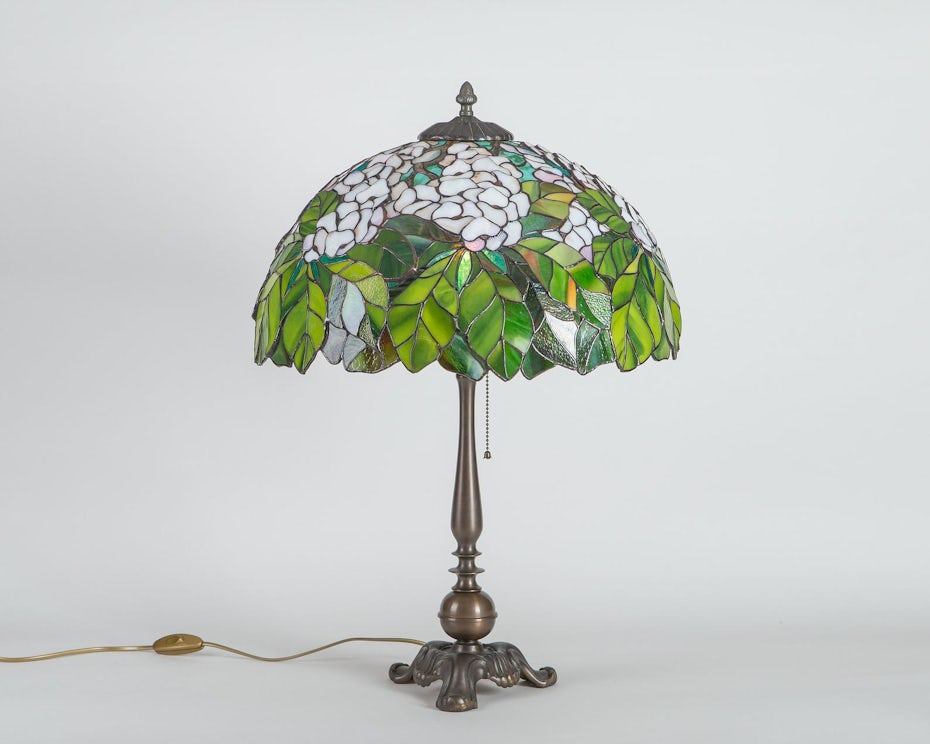
One of the objectives of Art Nouveau was to break down the separation betwixt Fine art and Applied Art. Fine Art can be described to exist art simply due to aesthetics, oft lacking concept simply judged primarily on its beauty. However, Applied Fine art embraced art with purpose, fine art that is practical to everyday and applied objects. This genre of art allowed not just the wealthy to access the beautiful things in life simply bring beauty into spaces anybody could enjoy, adding functional purpose, from architecture and interior design to graphic arts, jewellery and much more than. Many of the artworks in Art Nouveau were not paintings (which would often merely be attainable for the rich), merely objects of utilise such as vases, chairs, lamps and buildings.
The pioneers of Art Nouveau challenged lodge, including artists, craftsmen and -women of all kinds, to reestablish quality handmade crafts and create modern designs both for practical use besides equally beauty. This development made craftspeople reexamine regular objects, and come across them as potential masterpieces. With this in listen artists experimented with a range of elements such as creating free forms lines and curves, geometric shapes, all aspects that are now signature elements of Art Nouveau design.

The Art Nouveau movement also aimed to modify educational institutions. From the seventeenth to the nineteenth century the academic world of the Arts was dominated past a hierarchy where Fine art such as paintings and sculptures were seen as superior and therefore given more attention and opportunities. Art Nouveau shone a light on artists of all disciplines and appreciated the vast assortment of artwork.

Artists of Art Nouveau
—
Starting time in England with William Morris, give-and-take soon spread about the Art Nouveau movement and how information technology was transforming the art earth. One of the artists who expanded the Art Nouveau movement to Belgium was immature architect Victor Horta, who built a house in the Art Nouveau style. It's considered to be ane of the commencement truly Art Nouveau-inspired buildings due to its innovative utilise of materials.
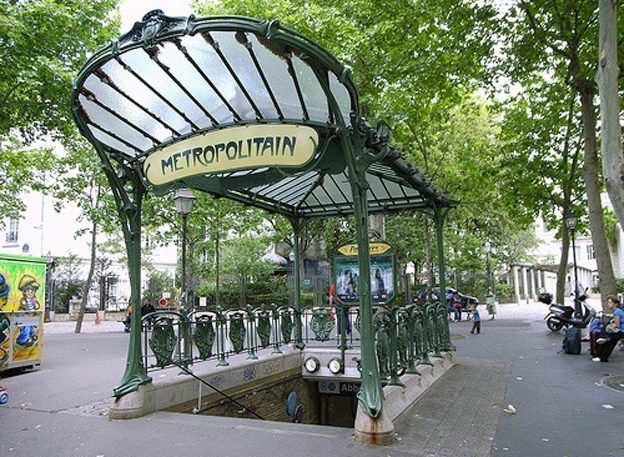
Influenced by Horta, French architect-designer Hector Guidmard adjusted the Fine art Nouveau style to the entrance of the Parisian Metro "le Metropolitain."
Fine art Nouveau blueprint gained more attention after the World Exhibition held in Paris in 1900s. The Exhibition showcased many Art Nouveau artists including another notable creative person, Alphonse Mucha, a Czech painter, illustrator and graphic designer. He was best known for his distinct and unique decorative theatre posters. He gained recognition especially from his posters of French actress Sarah Bernhardt because of how he conveyed Bernhardt from the perspective of the audition as admirers and observers of the star.

Other leading Art Nouveau architects and designers included the Hungarian architect Ödön Lechner. He was well known and recognised for his grandiose designs bringing life and color to the buildings of Budapest. Lechner combined Art Nouveau stylistic elements along with traditional Hungarian folk stories rooted in romance.
Elisabeth Sonrel, another Art Nouveau creative person, was a French painter and illustrator in the Art Nouveau manner with elements of the nineteenth-century British Pre-Raphaelites. Her work included allegorical subjects, mysticism and symbolism, as well every bit portraits and landscapes. Sonrel depicted arcadian women often with religious themes using watercolour paint. Her manner was fragile and particular orientated.
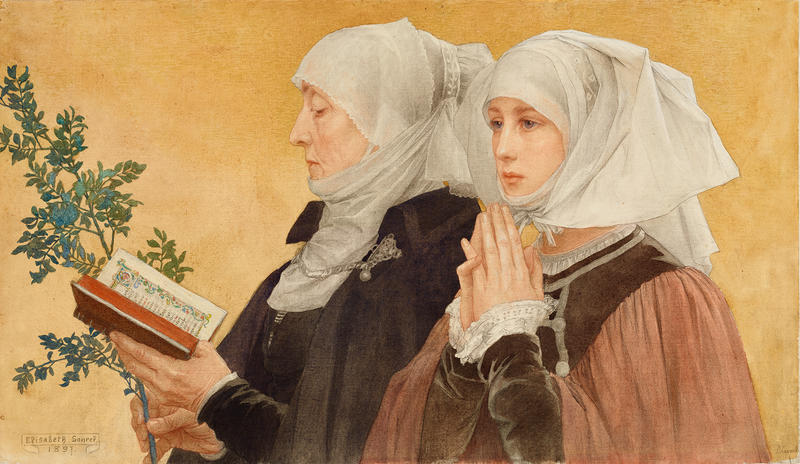
Central characteristics of Art Nouveau design
—
Artists from across diverse disciplines from painters, illustrators, jewellery and glassware designers employed specific techniques that identified them as artists of the Art Nouveau movement. These techniques depicted dreamlike imagery that represented the notion of thinking beyond the mould, illustrating a time of new thoughts coming to life. These dreamlike images were oftentimes shown through the following characteristics:
Sensuality
Art Nouveau reflected the sexual awakening that was occurring during that time. Women in Art Nouveau were often depicted with a sense of eroticism and other disciplines used sensual curved shapes and round forms to symbolise the body.
Today, we yet use the sensuality and eroticism of Fine art Nouveau to catch an audience's attention and to brand sensual products like exclusive food or fine dining, cosmetics, fragrances and alcoholic beverages. Accept a expect at the designs beneath to meet what we hateful.
Japanese inspired flat perspective
Siegfried Bing, a German-French art dealer, introduced Japanese art to the Westward and this profoundly contributed to the development of Art Nouveau pattern. Somewhen across Europe, Japanese art gained popularity in art circles, primarily due to the Exhibition in Paris, where Bing showcased more than 700 prints and more 400 books all from Japan.
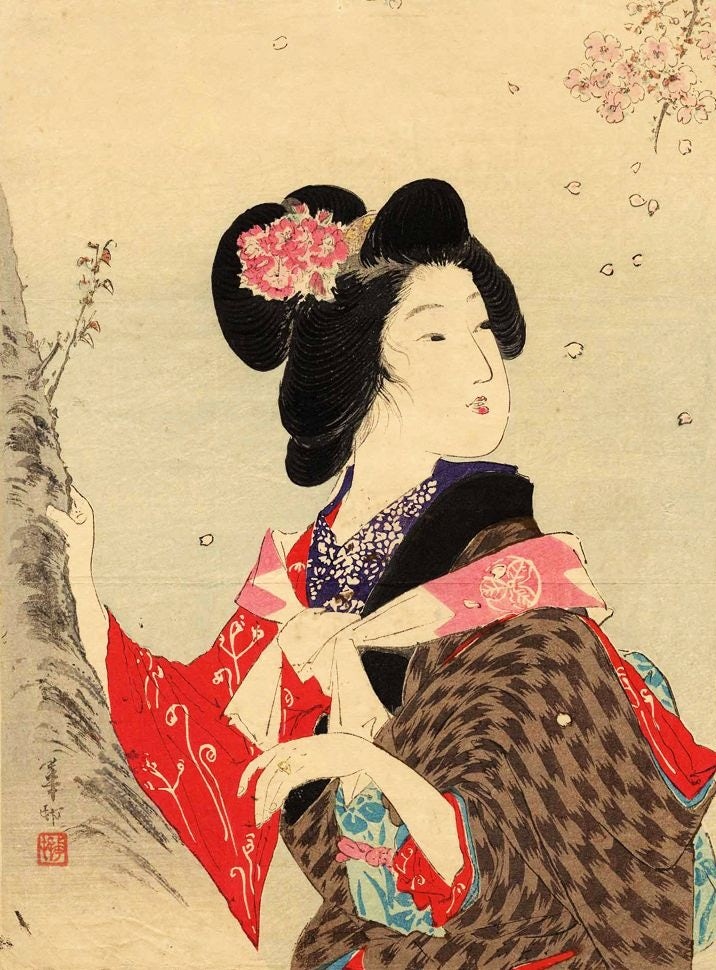
The fine art motion from Japan that influenced Art Nouveau the most was called ukiyo-e, which means "pictures of the floating world." Ukiyo-e was the elaborate process of creating woodblock prints that created apartment perspectives. The use of space, colour and decorative patterns used in Japanese artwork greatly inspired the same elements in Art Nouveau.
Curved and free-flowing lines
Artists in the Art Nouveau move invented a fashion where curves were dominant. The Whiplash was an iconic element characterised past a curved 'S' in a line frequently asymmetrical and inspired past nature. We tin find these lines in balconies, bannisters, facades, house entrances and frames.
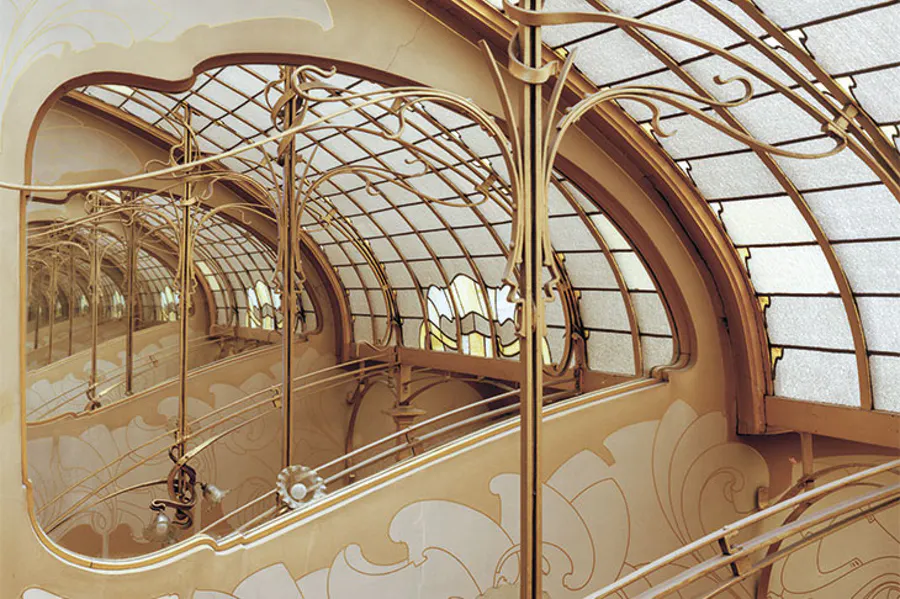
Today y'all can run across these curved and gratuitous-flowing lines used frequently in logo and packaging designs. Equally shown in the examples below by designers Renata_Costa and Mila Katagarova, the designs give a flowing look and experience. And the decorative and incriticate details in the designs reflect the architectural influence of Fine art Nouveau.
Floral forms
Many Fine art Nouveau artists included flowers or elements of nature such as lilies, irises, poppies, rosebuds, swans, peacocks, dragonflies, egg shapes, clouds, or h2o. Even depictions of women with beautifully long swaying hair were used to create interesting imitations of nature itself, contributing to the harmonious composition.
We run into this today when brands use floral forms to convey a sense of luxury, vitality and femininity. Floral designs with an Art Nouveau twist are used anywhere from posters, packaging and production labels to logos and invitation designs celebrating events like weddings or baby showers. They instantly make any design expect softer and more natural.
When to use Fine art Nouveau design in your branding
—
Art Nouveau blueprint shows united states of america how embracing and combining different cultures with respect and appreciation can reinvent and revive traditional styles. It's a classic mode that has been preserved and is still celebrated in the fine art world today every bit information technology was and so inclusive of all artists at the time.
Art Nouveau pattern is often used for visual identities that desire to communicate beingness organic or original, admiring nature, rooted in bringing life and beauty to all things too as conveying an air of elegance. If these are some of the elements you lot want your brand to represent, experiment with Fine art Nouveau design on your own or with help from a professional designer.
Desire to add together some Art Nouveau into your next design?
Work with our artistic customs of designers to make information technology happen.
Source: https://99designs.com/blog/design-history-movements/art-nouveau-design/
Belum ada Komentar untuk "What Types of Shapes Are Most Frequently Found in Artworks From the Art Nouveau Style"
Posting Komentar